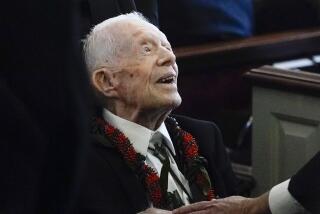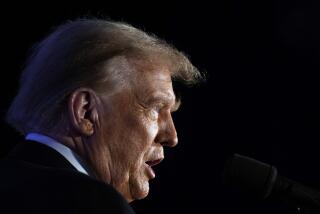Opinion: How old is too old to be president? We are entering uncharted waters

- Share via
In the entire history of the United States, we have had only two presidents who finished their terms in office after the age of 70: Dwight Eisenhower, who was 70 when his second term ended, and Ronald Reagan, who was 77. Until President Trump, we had never had a president who assumed office after turning 70.
In 2020, however, we could well have an election in which both of the major party candidates are septuagenarians. At the time of the next presidential inauguration, Trump will be 74. Today’s three Democratic front-runners, Joe Biden, Bernie Sanders and Elizabeth Warren, will be 78, 79 and 71, respectively.
Is that a problem? Maybe — or maybe not.
Certainly it’s important for the president of the United States to function at a high level. But people age very differently, so while one person may still be quite intellectually fit at 75 — or even 95 — another may show significant signs of age-related mental decline far earlier.
The fact that so many candidates in their seventies are in the race is in some ways a sign of progress. For decades, starting in 1935 when President Franklin D. Roosevelt established 65 as the age that Social Security benefits could be claimed, that has been considered “retirement age.” But a lot has changed.
In 1935, only about 57% of the U.S. population even lived to age 65, and the average life expectancy was 61.7 years. Today U.S. life expectancy is more than 78, and about 78% of Americans live to be at least 65. This demographic shift toward older, healthier people — referred to as a “silver tsunami” — is forcing us to reconsider the useful working lifetime including the optimal retirement age.
But that brings complications, too, especially for jobs as demanding as the presidency. While physical impairments that require retirement are generally apparent, neurological conditions can be less obvious, because changes in thinking are often subtle and take longer to be recognized. Cognitive functioning involves a range of factors, including attention, memory, problem-solving, decision-making and processing speed. Studies have shown that these functions decline at different rates with aging, and some — those dependent on knowledge and experience — can actually improve with age.
But the dilemma is that we can’t know how a particular person will age. We have had several presidents we now know were cognitively impaired while in office. Woodrow Wilson suffered multiple strokes, including one that left him largely incapacitated in the fall of 1919, just before the Treaty of Versailles went before the U.S. Senate for ratification. As a result of the stroke, Wilson was unable to effectively lobby for the treaty he had personally negotiated, and it was rejected by the Senate. Franklin Roosevelt is widely acknowledged to have been cognitively impaired when he met with Churchill and Stalin at Yalta to negotiate the shape of the post-World War II world. Two months after the gathering, Roosevelt died of a stroke.
Congress proposed the 25th Amendment, which was ratified in 1967, to protect against an impaired president. Among other things, it says that if the vice president and a majority of the Cabinet secretaries send a letter to the House speaker and the president pro tem of the Senate declaring that the president is “unable to discharge the powers and duties of his office,” then the vice president will assume power. But invoking the amendment would be a difficult call.
Because of a lack of awareness or denial, dementia is difficult to detect in the early stages, and the first signs are often subtle, detected by family or co-workers but not by everyone. The incidence of dementia, the severe form of cognitive decline, is estimated to be present in 10% of people over the age of 65, and increases with age to reach 40% in those over 80.
Importantly, the cognitive changes seen with normal aging are highly variable. Some older people retain the ability to solve complex problems and learn new languages as well as a 30-year-old. In contrast, others have problems finding the right word or taking the correct medications. Normal aging is most commonly associated with mild distractibility, less efficient processing of information and mild difficulty doing two things at once, learning new things, and solving novel problems. In some cases, the accumulated wisdom of a lifetime may more than make up for mild cognitive difficulties. But it’s very hard to know.
With today’s trend toward older people running for president, we need new rules. Age, in and of itself, should not disqualify someone from seeking the office. But there needs to be some way of evaluating mental fitness.
One idea would be to require that the president undergo annual evaluation by an independent panel of physicians that includes extensive cognitive examination by a neuropsychologist. The most important aspect of the evaluation would be to note changes from lifelong cognitive functioning and to determine if the changes are significant enough to merit a diagnosis of dementia. Having a baseline record of performance on neuropsychological tests would allow the panel to detect a decline in cognition at an early stage.
It would be ideal, of course, to know about any cognitive difficulties a candidate was having before an election. But that’s a fraught subject, and might best be left until after the country feels comfortable with regular evaluations of the president.
The capacity to reason and to use a large knowledge base to make wise judgments does not necessarily decline with age. But it’s crucial that any deterioration in those areas in a sitting president be detected before it leads to dangerous decisions.
Gary Rosenberg is a physician, professor and director of the University of New Mexico’s Memory and Aging Center. Center. Kathleen Y. Haaland is a neuropsychologist and professor of psychiatry and behavioral sciences at the University of New Mexico.
More to Read
A cure for the common opinion
Get thought-provoking perspectives with our weekly newsletter.
You may occasionally receive promotional content from the Los Angeles Times.










